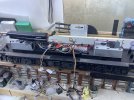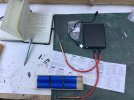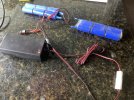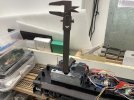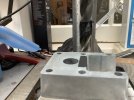rpiboy01
Registered
I'm sure there a million opinions on this, which is one reason I didn't bother doing a search, as I would rather just see what people reply with here. Now that I've got my loco operational using the antique Locolinc control system, I need to consider either a battery pack, or pulling apart the 4-4-0 Bachman to reconnect the track pick-ups as I'm fairly certain the Locolinc installer "clipped" them (though I'm not 100% confident either, more testing tomorrow night).
Regardless, while I continue to asess need to carry on with research.
The Locolinc control board is a 2amp board from what I can tell, and on the bench it happily ran with about 17v being applied from a power pack. Board is rated for 12v - 18v. Suggestions on where to procure an appropriate battery pack? Is Li-ion the rage now? For now we won't be doing much but running around in a loop "under the Christmas tree". Long term hope to construct a small outdoor layout that includes operations and not just running in circles, but that is likely a few years away yet.
Thanks in advance & cheers!
Regardless, while I continue to asess need to carry on with research.
The Locolinc control board is a 2amp board from what I can tell, and on the bench it happily ran with about 17v being applied from a power pack. Board is rated for 12v - 18v. Suggestions on where to procure an appropriate battery pack? Is Li-ion the rage now? For now we won't be doing much but running around in a loop "under the Christmas tree". Long term hope to construct a small outdoor layout that includes operations and not just running in circles, but that is likely a few years away yet.
Thanks in advance & cheers!

